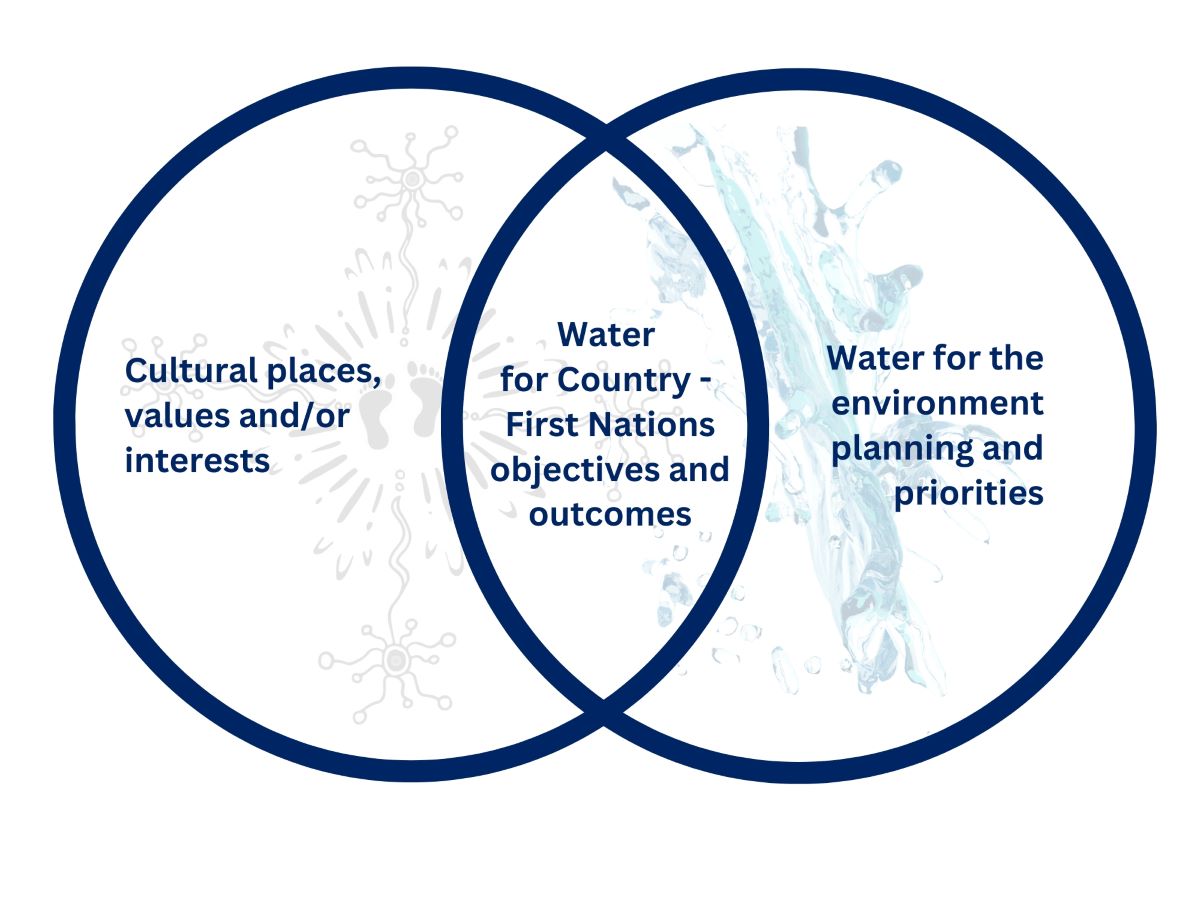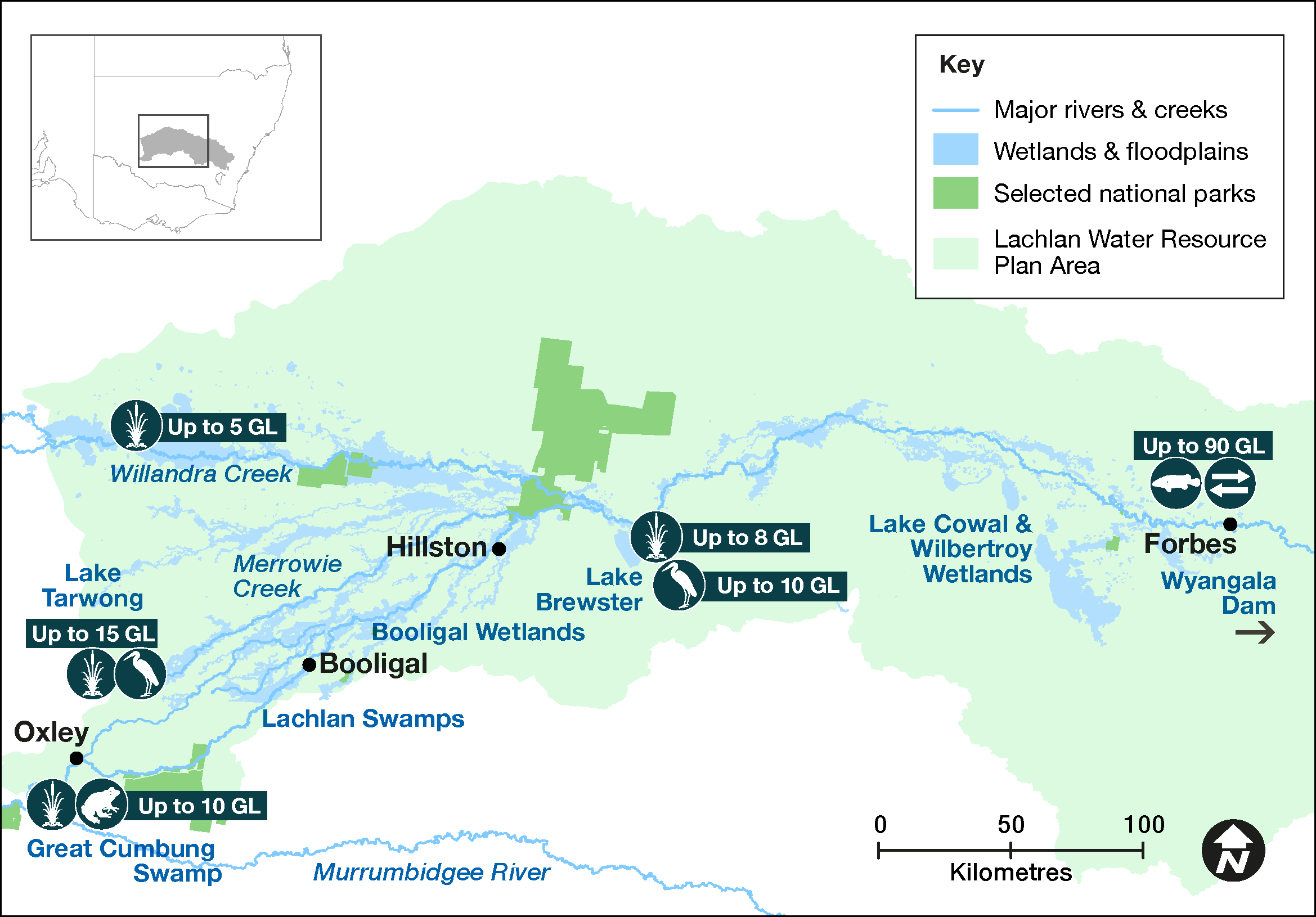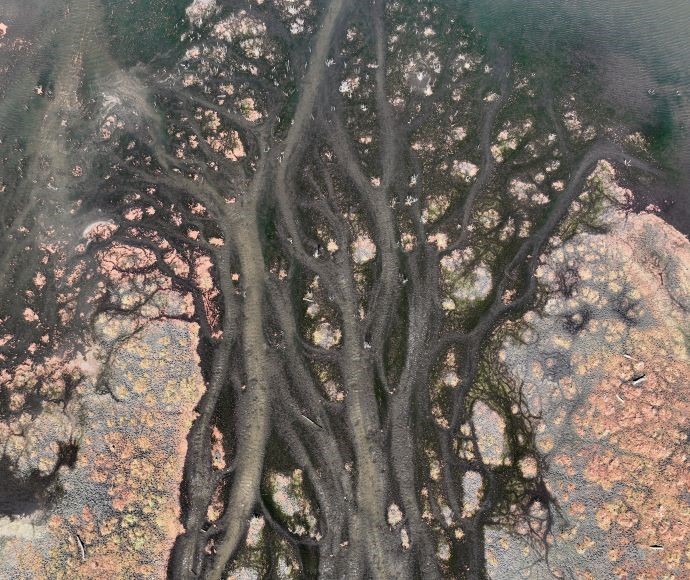Water that is allocated and managed specifically to improve the health of rivers, wetlands and floodplains is known as water for the environment.
NSW environmental water management teams work with local community advisory groups including landholders, Aboriginal stakeholders, partner agencies and other interested community members to develop detailed annual plans for the use of water for the environment in each catchment, including how its use is prioritised.
The catchment
The Lachlan catchment covers an area of 90,000 km2. Nearly 1,300 km of the 1,400-km river is regulated by water storages, of which Wyangala Dam is the largest at 1,220 gigalitres (GL).
The river originates near Gunning in the tablelands and ends at the Great Cumbung Swamp. Important sites include the Booligal Wetlands, Lake Brewster, Lake Cowal, Great Cumbung Swamp and Lachlan Swamp, all of which are listed in the Directory of Important Wetlands in Australia.
The Lachlan catchment has important Aboriginal cultural values. Environmental watering actions consider Aboriginal values and uses in consultation with communities.
The Lachlan is Country to the Wiradjuri, Nari Nari, Mutthi Mutthi, Ngiyampaa and Yita Yita Aboriginal people.
Water for rivers and wetlands
In 2023–24, water managers will focus on completing a cycle of wetland water regimes including a natural drying phase. They will consider the seasonal inundation of priority wetlands and floodplains to maintain improvements in condition of long-lived woody shrublands (lignum, nitre goosefoot), black box and river red gum wetlands, as well as macrophyte, rushes and reed beds. Work will continue on development of a strategy to support the full life cycle requirements of threatened species of waterbirds, native fish and frogs. This may include flows to enable breeding, recruitment and dispersal at a catchment scale, as well as to support permanent areas of habitat under dry conditions.
The full 350 GL of translucent flows was delivered each year for the last 3 years and more of the lower Lachlan floodplain remains inundated since summer 2023. Over 100,000 ibis nests were counted in the Booligal Wetlands and southern bell frogs bred in the Great Cumbung Swamp.
During 2022–23, the Department of Climate Change, Energy, the Environment and Water (the department) worked with partner agencies and stakeholders to deliver more than 30 GL of held environmental water and planned environmental water. Water for the environment was pumped into lower Merrimajeel Creek for the first time supporting Dry Lake vegetation and Wiradjuri cultural connections. Two Lachlan River freshes were delivered after flooding receded to reduce the risk of widespread fish kills from poor water quality, particularly blue green algal blooms.
Aboriginal water management priorities
Water for Country is environmental water use planned by the department and Aboriginal people to achieve shared benefits for the environment and cultural places, values and/ or interests.

Environmental water managers have been working to support Aboriginal people’s priorities in water management.
In 2023–24 we will partner with Aboriginal groups in the Lachlan to support priority outcomes for the catchment. We will continue to be guided by Ngiyampaa people in delivering flows to Booberoi Creek and expand into Willandra Creek. As part of the water management plan project, we are seeking to build relationships and support On Country connections with Wiradjuri people in the mid Lachlan, and with Nari Nari, Mutthi Mutthi, Wiradjuri and Yita Yita people in the Great Cumbung Swamp region and lower Lachlan floodplain.
Management will also be guided by the Mawambul co-management group for Kalyarr National Park, and Wiradjuri aspirations for Dry Lake (Keiross Lake) and Lower Mirrool Creek Floodplain. In addition, we aim to learn from Mutthi Mutthi people on the values for Box Creek below Lake Tarwong, recognising the important role of Aboriginal knowledge and perspectives in water management responsibilities.
Weather and water forecast
The prolonged wet conditions and significant flooding from 2020 to 2023 means conditions for early 2023–24 are wet to very wet. The maximum volume of all environmental water provisions is likely to be available during 2023–24 given most storages remain near full capacity.
However, as at early June an El Niño1 watch was issued and the April to June 2023 forecast is for below median rainfall and above median temperatures. Streamflow forecast for March to May 2023 is near median flow. With Wyangala Dam near full capacity, the traditional winter storage inflow and downstream tributary inflow period will influence how wet the system is and our need for environmental water.
In summary, the 2023–24 water year will start with high available water resources and a residual wet landscape. A return to moderate to dry rainfall–inflow conditions is anticipated with a 50% chance of El Niño developing in late 2023 into 2024.
Water managers have prepared watering plans that consider a range of weather and water availability scenarios. This is known as resource availability scenario planning. Wet to very wet conditions are forecast for the Lachlan catchment in 2023–24.
1. The interaction between the sea surface and atmosphere over the Pacific Ocean results in dryer (El Nino) or wetter (La Nina) conditions.
Current forecast: Wet to very wet
| Conditions | Main aim | Other aims |
|---|---|---|
| Very dry | Protect | Avoid critical loss Maintain key refuges Avoid catastrophic events |
| Dry | Maintain | Maintain river functioning Maintain key functions of high priority wetlands |
| Moderate | Recover | Improve ecological health and resilience Improve opportunities for plants and animals to breed, move and thrive |
| Wet to very wet | Enhance | Restore key floodplain and wetland linkages Enhance opportunities for plants and animals to breed, move and thrive |
Key planned actions for 2023–24
Waterbirds
If needed, core breeding, foraging and migratory wader habitats will be topped up in early spring and autumn to provide food and shelter for waterbirds (up to 10 GL). Water managers will make additional water (up to 10 GL) available to support bird breeding events, such as the pelicans at Lake Brewster.
Native fish
Water managers will deliver up to 30 GL in a series of whole of system seasonal freshes from Wyangala (including mid Lachlan anabranches) to provide food and cues to move and breed for native fish populations (multi-site and multi-objective flow). These freshes will also improve water quality and reconnect isolated reaches and pools after low flow periods.
Vegetation
Water managers will focus on successive waterings of floodplain vegetation:
- lignum shrublands in Merrowie Creek, Box Creek and Willandra Creek
- phragmites, reed beds and river red gum woodland in the Great Cumbung Swamp (up to 25 GL).
These watering actions will promote recovery in vegetation condition and recruitment. These sites will also contribute to waterbird and connectivity outcomes.
Additional volumes (up to 8 GL) will promote seed setting and establish inflow and outflow wetlands at Lake Brewster.
Connectivity
Water managers will consider a system-scale watering event (up to 90 GL) in winter 2024, targeting overbank and small wetland flows for follow-up floodplain watering for long-term resilience and refuge habitat.
Map of proposed annual priority targets in the water resource plan area 2023–24

Map of proposed annual priority targets in the Lachlan Water Resource Plan area 2023–24
The department is supporting the health and resilience of rivers and wetlands by delivering water for the environment where and when it is needed. We use the best available science, management expertise and experience to manage water across the landscape. This statement of annual priorities identifies the waterways and wetlands that are likely to receive water.
Our decision-making process considers:
- expected availability of water in the coming year
- conditions of the previous year
- current health of the plants and animals in these ecosystems.
About water for the environment
Water for the environment delivers benefits for communities, rivers, wetlands and wildlife across New South Wales.
Healthy, connected rivers and floodplains are a focus for tourism, fishing, recreation and relaxation. Rivers carry water to our homes, schools, farms and businesses, and along the way, support countless species including native fish, waterbirds, frogs, plants and more.
Rivers and wetlands have great cultural and spiritual significance for Aboriginal people.
Water for the environment is a critical tool to maintain and enhance the rivers, wetlands and wildlife we all love.
Working with communities
Local communities are at the heart of everything we do.
We involve the broader community by holding site tours and forums, and online and in-person events.
NSW water management teams consult regularly with community-based environmental water advisory groups.
Environmental water advisory groups members include local landholders, recreational fishers, Aboriginal people and local government representatives. Their advice helps to inform the decisions made by our local environmental water management teams.
Planned environmental water
| Source | Maximum volume available (gigalitres) | Volume expected 1 July under current conditions (gigalitres) |
|---|---|---|
| Water quality allowance | 20 GL | 20 GL |
| Wyangala environmental water allowance | 10 GL | 10 GL |
| Lake Brewster environmental water allowance | 10 GL | 10 GL |
| Translucent flows | Up to 350 GL | Depends on significant inflows to reach triggers |
Water licenced to New South Wales
| Source | Maximum volume available (gigalitres) | Volume expected 1 July under current conditions (gigalitres) |
|---|---|---|
| General security | 37.5 GL | 37.5 GL |
| High security | 1.8 GL | 1.8 GL |
Water licenced to the Commonwealth
| Source | Maximum volume available (gigalitres) | Volume expected 1 July under current conditions (gigalitres) |
|---|---|---|
| High security | 0.9 GL | 0.9 GL |
| General security | 87 GL | 87 GL |
Notes: This is an indicative summary of expected volumes to be available. For further detail and information on available volumes you can contact the region via the Department of Climate Change, Energy, the Environment and Water on 1300 361 967.
1 gigalitre = 1000 megalitres; 2.5 megalitre = 1 Olympic swimming pool.
Outcomes of water for the environment
Water for the environment has been delivering outcomes for rivers, wetlands and wildlife for 30 years.
We deliver flows that:
- trigger native fish to breed and move
- support waterbirds to nest and feed
- connect rivers and floodplains
- water forests and floodplains
- allow plants to grow, flower and set seed
- create refuge during droughts
- enhance outcomes during wetter times
- release vital nutrients from the floodplain floor that underpin the aquatic food web.
It’s habitat restoration on a landscape scale.

The Lachlan River ends at the Great Cumbung Swamp
More information
- Long-term water plans
- Lachlan Long-Term Water Plan
- Lachlan Environmental Water Advisory Groupopens a new window
- Water Sharing Plan for the Lachlan Regulated Water Source
- Murray Darling Basin Planopens a new window
- Murray Darling Basin Authorityopens a new window
- Commonwealth Environmental Water Office: Lachlan catchmentopens a new window
Planned and past watering events
- Annual environmental water priorities in the Lachlan catchment 2022–23
- Lachlan Catchment – Water for the Environment: Annual Priorities 2021–22
- Lachlan catchment: Annual environmental watering priorities 2020–21
- Lachlan catchment annual environmental watering priorities 2019-20
- Lachlan catchment annual Environmental Watering Priorities 2018-19
- Lachlan catchment annual environmental watering priorities 2017-18
- Lachlan Water Resource Plan Area: Statement of annual environmental watering priorities 2016–17
- Lachlan Water Resource Plan Area: Statement of annual environmental watering priorities 2015–16
- Lachlan Riverine Environmental Water Management Planopens a new window
- Water for environment outcomes 2022–23
- Water for environment outcomes 2021–22
- Water for environment outcomes 2020–21
- Water for environment outcomes 2019–20
- Water for environment outcomes 2018–19
- Water for environment outcomes 2017–18